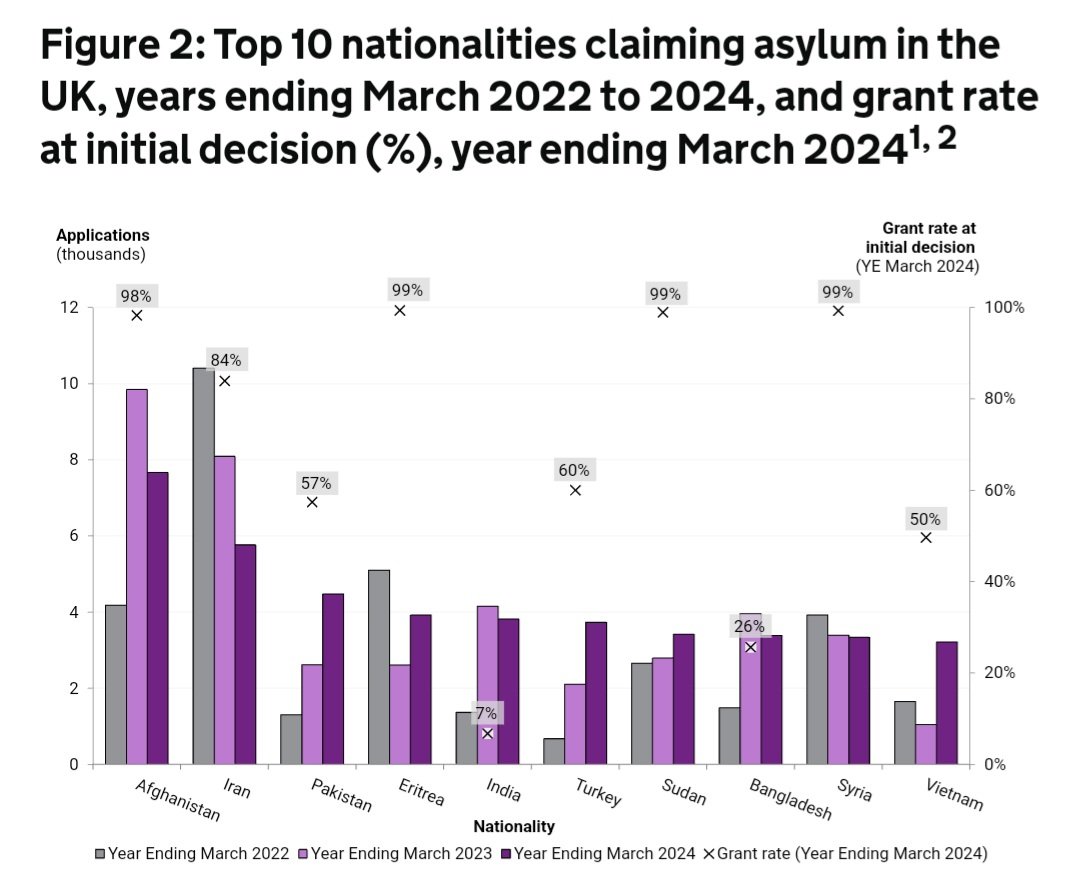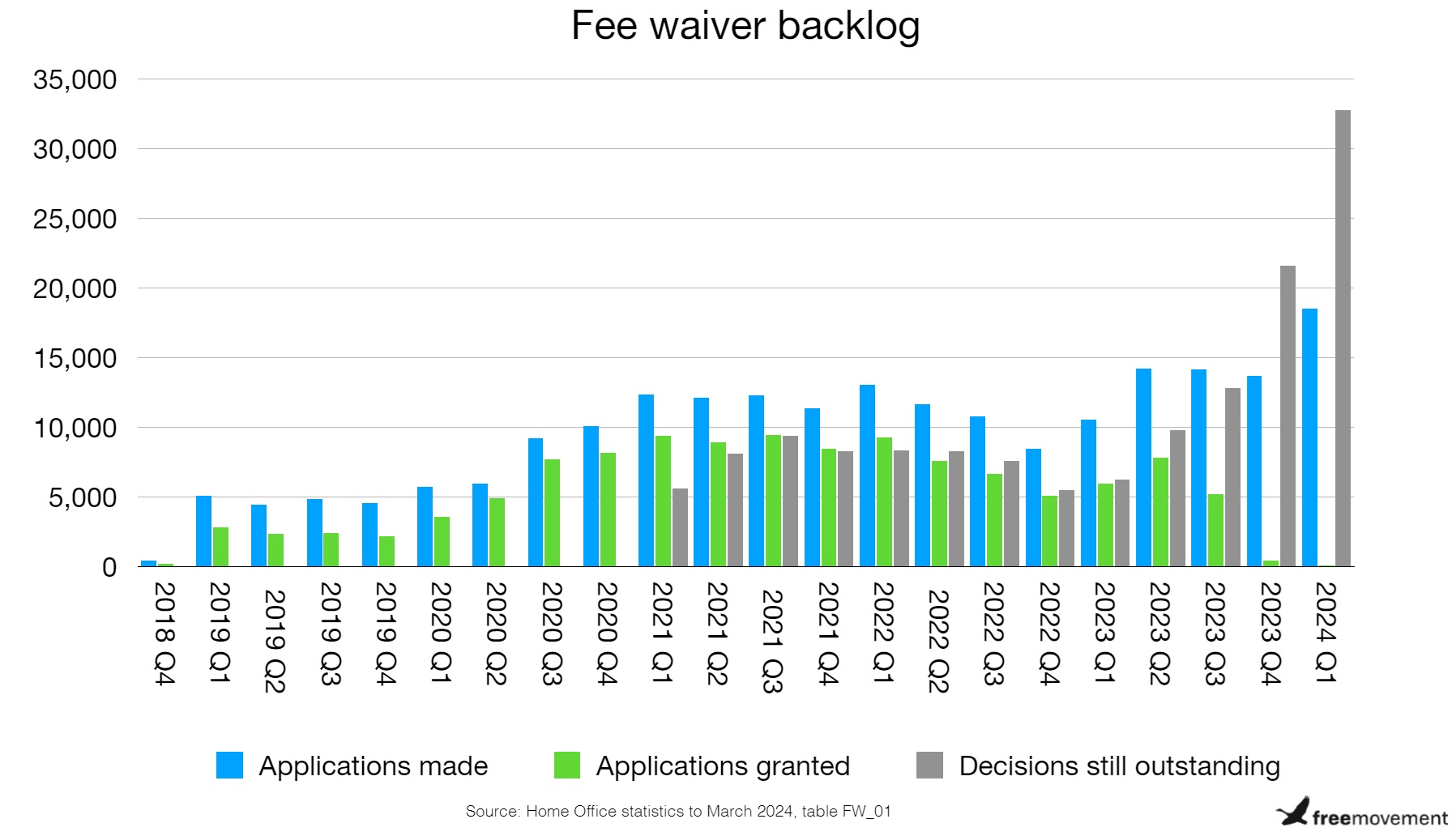- BY Sonia Lenegan

Home Office statistics link drop in asylum grant rate to Nationality and Borders Act 2022
THANKS FOR READING
Older content is locked

A great deal of time and effort goes into producing the information on Free Movement, become a member of Free Movement to get unlimited access to all articles, and much, much more
TAKE FREE MOVEMENT FURTHER
By becoming a member of Free Movement, you not only support the hard-work that goes into maintaining the website, but get access to premium features;
- Single login for personal use
- FREE downloads of Free Movement ebooks
- Access to all Free Movement blog content
- Access to all our online training materials
- Access to our busy forums
- Downloadable CPD certificates
Table of Contents
ToggleThe Home Office has published statistics for the period January to March 2024 showing a marked drop in the grant rate for asylum cases, tens of thousands of EU Settlement Scheme applications rejected as invalid, and a fee waiver backlog that seems to be rapidly spiralling out of control. My full write up is below and the Home Office summary pages are listed here and the underlying data is here.
Asylum
The asylum summary reports a 14% decrease in applications for the year ending March 2024, driven by an 80% decrease in Albanian claims. As a result, Albania is no longer a top ten nationality for number of claims.
The overall grant rate dropped to 62% from 74% the previous year. The drop in grant rate towards the end of last year was expected because the Home Office had focussed on high grate rate countries at the start of the backlog clearance exercise, leaving the cases more likely to be refused until last.
However one very important point to note on this is that the grant rate in the period January to March 2024 dropped all the way down to 43%. The Home Office has stated that the majority of cases decided in that period were subject to the higher standard of proof set out in the Nationality and Borders Act 2022, explicitly linking this to the very low grate rate.
A higher refusal rate will mean a higher number of decisions being appealed and there is already a very lengthy wait to have these appeals heard. In addition, there are very few legal aid lawyers available to assist with asylum appeals. This means that the First-tier Tribunal will be faced with an exponential increase in the number of cases that are waiting to be heard (above its existing backlog). These will be cases with litigants in person which necessarily involve the need for more time and resources. Instead, months and months have been wasted on preparation for the Illegal Migration Act and the Rwanda scheme. A plan is needed, and fast.
Back to initial asylum decisions, there has been a 35% reduction in the number of cases waiting for a decision, this stood at 86,460 applications (118,329 people) at the end of March 2024. However it is important to remember that many of the people who arrived since 7 March 2023 (including the vast majority of the 34% of new claims made by people who came by small boat) are prohibited from a grant of leave under the Illegal Migration Act. It remains unclear what can be done to progress those cases given the ongoing failure by the Home Office to provide any explanation or guidance.

Claims by Turkish nationals are up 78%. I commented in November 2023 that it was notable that Turkish nationals were now the fourth highest nationality arriving across the Channel and that the grant rate stood at 89%. They are now the third highest nationality arriving by small boat (11% of arrivals are Turkish). Something has clearly changed, likely in response to this increase. I can see that several country policy notes were updated late last year and now the grant rate has plummeted.

In the year ending March 2024 there were 24,384 withdrawn asylum claims, compared with 9,971 the year before. 78% of those withdrawals were decisions made by the Home Office rather than the individual. Hopefully now the threat of Rwanda appears to be receding we will see some of these people prepared to re-engage with the system.
Inadmissibility
We have not been provided with any inadmissibility data in today’s statistics, but I am going to mention it briefly anyway. Following the Prime Minister’s statement today that no flights to Rwanda would take off before the election, and Labour’s commitment not to send anyone there, there is now no “safe third country” to send people who are waiting in the inadmissibility process.
We can see in the data on irregular arrivals that only a very small number of people who arrive via small boat are having their claims progressed. Only 1% of those who arrived this way in the year ending March 2024 have received a decision. For the period January 2018 to March 2023 this is 66%. The total number of arrivals since January 2018 is 117,697.
In the absence of any action taken by the Home Office to progress these cases, the judicial reviews challenging the use of the inadmissibility process must continue to go in en masse (as well as bail applications for anyone detained with the threat of Rwanda). We have an article on how to get claims out of inadmissibility and into the asylum system and Jed Pennington’s webinar on this topic will be online very shortly.
EU Settlement Scheme
The summary for the EU Settlement Scheme shows that the number of late applications remains high, although this has recently started dropping down to less than ten thousand per month. In the first three months of 2024 there were 30,410 such applications (13,070 in January, 9,960 in February and 7,380 in March).
The large number of late applications to the EU Settlement Scheme being rejected as invalid continues to be an issue, despite the guidance being amended in January this year. Since the August 2023 changes, there have been 60,840 late applications rejected as invalid. In total, since the scheme formally closed at the end of June 2021 there have been 112,500 applications rejected as invalid, so over half of those have happened in the period of less than a year since the change in the rules.
Detention and returns
The detention summary shows that Albanians are still the largest nationality being held in immigration detention and they accounted for 36% of those entering detention in the year ending March 2024.
While a year on year comparison shows 23% fewer people entering immigration detention in the year ending March 2024, the number of people held in immigration detention at the end of March 2024 was 20% higher than on the same day in 2023.
People are also being held for considerably longer. Of those leaving detention, only 34% do those because they have been removed from the UK.

There was a 70% increase in enforced returns, totalling 7,016 people, but again this change was driven by Albanians as 2,842 people were returned in the year ending March 2024. As the number of Albanians entering the system has dropped, there will be fewer to target for these returns and so this number seems likely to start dropping. We can already see a drop from 1,766 for the period October to December 2023 to 1,393 for January to March 2024.
The “port returns” data covers people who were refused entry at the border and then left the UK. In the year ending March 2024 59% of all port returns were EU nationals (this was 17% pre-Brexit) and of those 48% were Romanians.
There have been some fairly dramatic changes in port returns for certain non-EU nationalities. Chinese nationals have seen an increase of 352% in such refusals, Columbian nationals 167% and Indian nationals 77%.
Work routes
The summary for work visas shows that in the first quarter of 2024 75% fewer ‘Skilled Worker – Health and Care’ visas were granted, (9,088 in total) than the same period in 2023. This is because of a large reduction in the ‘Care workers and home carers’ category.

Given the huge fall in numbers that took place before the mid-February change preventing care workers bringing their family, it is difficult to tell what impact that change has actually had. There certainly does not appear to have been a last minute rush of applications ahead of the changes.
Graduate visas also fall within the work route data and we can see that there were 139,175 grants to main applicants in the year ended March 2024 which is a 49% increase on the previous year. Indian nationals are the highest proportion in the route, representing 46% of the total grants.
Fee waivers
Following the huge increase to the immigration health surcharge that took effect in January this year, the fee waiver backlog continues to grow.

One concerning thing I noticed is that while the number of grants appears to have ground to a halt, the number of refusals has not. So for the period January to March 2024 the data shows 1,056 refusals and 69 grants. In July to September 2023 this was 5,202 grants and 3,403 refusals. It is really unclear what is going on with this team but their workload is certainly not going to decrease any time soon.
Resources must be put into this and even more importantly processes should be simplified. Too often unnecessary requests for further information are being made which just causes further delays.
What remains missing and would be very useful to see is a proper breakdown of what is going on with fee waiver applications, including who is using them. I suspect that most fee waiver applications are made in relation to the ten year route in Appendix FM. Abolishing that and allowing everyone with leave under Appendix FM to settle after five years would seem a pragmatic and humane approach which would dramatically reduce the amount of work the Home Office would need to expend on fee waiver applications. Otherwise it is very difficult to see what they will do to get themselves out of that mess, and it doesn’t seem to be on anyone’s political agenda, in contrast to the asylum system.
Conclusion
As ever, there is a lot of interesting data in today’s release but it really does highlight that there are several different disasters happening in the Home Office (or in the case of the First-tier Tribunal – caused by the Home Office) at the moment. The next government needs to get to grips with all of this very quickly and be ready with a plan to sort things out.
SHARE

